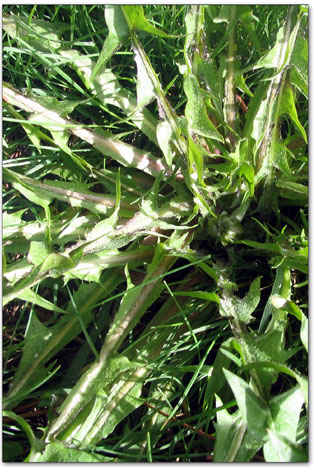| ||
Those dandy lion’s teeth
by Chef Boy Ari I know a girl who gardens with a bowl of salad dressing. In spring, as she prepares for planting, she pulls young volunteers of various plant species from the wet earth. Many such unwitting specimens are then dipped into her spicy vinaigrette, held daintily by the root end, and carefully lowered into her mouth. Beneath last year’s sunflowers the ground is thick with four-leaved sunflower shoots, which she pops like M&Ms, along with the occasional baby sprout of clover or sedum. But her favorite weed of all is the big one that’s everywhere, all the time, and best for salad. Of course you’ve heard that dandelions are edible. Many have acted on this hearsay and shortly thereafter spat in disgust, mouths contorted in bitter agony. To many, dandelions must seem like the ultimate in bad-tasting health food. And that’s too bad, because if more people knew otherwise, a lot of really good food wouldn’t get wasted at the very moment we need it most. According to wild-foods sage and former NPR commentator Kim Williams, dandelions were an important part of settler life in the West. “By the end of the winter,” she writes in the Kim Williams Cookbook and Commentary, “people felt run-down, out of energy. Actually, what they were out of is vitamins. They were living on bread, potatoes and salt pork.” Perhaps, after a wintertime diet like that, even the bitterest of greens tasted like ambrosia. But in the early spring, it turns out, dandelion greens aren’t bitter at all. And when the first flower buds pop up, they too are good eating, steamed or stir-fried. The name dandelion comes from the French dent de lion, meaning lion’s tooth, in reference to the plant’s jagged leaves. American Indians prized dandelions not only as food, but as medicine – most commonly for digestive ailments. Science now tells us that dandelion greens are some of the most vitamin and mineral-rich greens you can find, and especially good sources of vitamin A, vitamin C, iron and calcium. The roots are said to work as a coffee substitute. You clean them (leaving the skin on), cut them into pieces, roast them, grind them and make “coffee.” Having tried this, I recommend that you don’t. While some may like the taste of this beverage, few are likely to mistake it for coffee. In my experience, cooking and eating is a much better use for dandelion roots. You can also make wine or mead from the bright yellow flowers. While the name “dandelion wine” rolls off the tongue in an idyllic, almost nostalgic way, I’m not sold on the product itself – especially after having gone through the painstaking business of deconstructing the flowers into individual yellow flower parts and then the business of fermenting them. Rather than deepen my love for this fabulous little plant, this experience taught me little but that you can make wine out of almost anything. While dandelions generally taste better in early spring, the mature greens can be boiled twice, changing the water between rounds, to remove the bitterness. Personally, I feel that by the time the dandelion greens have turned bitter, the spinach in my garden is big enough to eat, and other greens aren’t far behind, so why bother? Clearly, there are lots of ways to go wrong when dealing with dandelions. But if you stick to young specimens (untreated with lawn chemicals or dog pee!) you’ll be fine. A good trick is to collect dandelions gathered from shady places, or at higher elevations. These will be sweeter. Kim Williams recommends searching for dandelions “underneath a flatbed truck on the north side of a barn.” The other day I was moving a pile of straw off my lawn, and underneath the straw I found some robust dandelion plants growing in the dark. The big leaves were a very pale shade of yellow, lacking the green of sun-induced chlorophyll. The taste was as mild as lettuce. I gave them to the girl who weeds with a bowl of salad dressing, and she made a salad. For the dressing she used a few cloves of garlic, fresh ginger to taste, equal parts cider and rice vinegar and half a part balsamic vinegar. She combined these in a blender and then blended in an equivalent volume of olive oil, added soy sauce to taste, and then blended again. I didn’t get to try the salad because she ate it all. Kim Williams’ next-door neighbor Eunice Brown used to make the following salad: Wash and pat dry dandelion leaves, then shred. Chop two strips of bacon and cook, then pour off the grease. Add one egg, slightly beaten, 1/3 cup half & half, 1/4 tablespoon sugar and 1 tablespoon vinegar. Stir over low heat until thick. Pour this dressing over the dandelion leaves and serve, topped with chopped green onions. I like this salad because it’s rich in the other vitamin B: bacon! Eunice recommends serving this salad with fresh trout – with the liver and roe fried with wild onions in the leftover bacon grease. •
|


